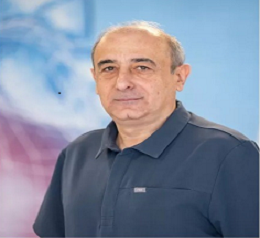9th Edition
World Heart Congress
THEME: "Heartbeat of Change: Inspiring Solutions for Global Cardiac Health"
 17-18 Nov 2025
17-18 Nov 2025  Dubai, UAE (Collaboration with the Armenian Cardiologists Association)
Dubai, UAE (Collaboration with the Armenian Cardiologists Association) THEME: "Heartbeat of Change: Inspiring Solutions for Global Cardiac Health"
 17-18 Nov 2025
17-18 Nov 2025  Dubai, UAE (Collaboration with the Armenian Cardiologists Association)
Dubai, UAE (Collaboration with the Armenian Cardiologists Association) 
Erebuni Medical Center, Armenia
Title: Clinical Outcomes and Recurrence Risk in PPCM Under Guideline-Based Management: A Multicenter Analysis
In 1988, he graduated from Yerevan State Medical University. From 1988 to 1990, he completed a postgraduate training program at Yerevan State Medical University and was qualified as a cardiologist. Since 1990, he has been working at Erebouni MC—since 2001 as the Chief of the Urgent Cardiology Department, and since 2015 as the Head of the Erebouni Cardiology Center.
Since 2014, he has been a Professor at Yerevan State Medical University and the Chief Cardiologist of the Republic of Armenia. In 1995, he defended his thesis and was awarded the titles of MD and PhD; in 2014, he became a Doctor of Medicine. In 2003, he received a Diploma as an Endovascular & Interventional Cardiologist. In 2010, he became a Fellow of the European Society of Cardiology.
He is the President of the Armenian Cardiologists Association, a Member of the Acute Cardiovascular Care Association, a Member of the Heart Failure Association of the ESC, and a Member of the American Society of Echocardiography.
Objectives: This multicenter study evaluated clinical outcomes, recovery of left ventricular ejection fraction (LVEF), changes in NT-proBNP levels, as well as factors associated with non-recovery in patients with peripartum cardiomyopathy (PPCM) managed according to contemporary heart failure (HF) guidelines.
Methods: This observational cohort study, conducted from 2015 to 2023, included 98 patients with confirmed PPCM. All had LVEF >50% before pregnancy or in the first trimester. PPCM was diagnosed based on HF symptoms, LVEF <45%, and NT-proBNP ?300 pg/mL. During pregnancy, all received beta-blockers, 61% received diuretics, and 50% received spironolactone. Postpartum treatment included ACEi/ARNI (69%), SGLT2 inhibitors (10%), and digoxin (10%).
Results: All patients were diagnosed with PPCM in the third trimester and were followed for 6 months after delivery. Baseline LVEF was 37.5 ± 3.2%. Patients were retrospectively grouped into recovered (Group 1, n = 40; LVEF increased by ?10% and/or reached ?50%) and non-recovered (Group 2, n = 58; LVEF remained the same, declined, or improved by less than 10% from baseline). NT-proBNP averaged 650 ± 150 pg/mL at baseline. After 6 months, Group 1 showed a significant drop to 250 ± 50 pg/mL (p < 0.05), while Group 2 remained elevated at 850 ± 65 pg/mL (p < 0.05). Non-recovery was independently associated with age >40, multiparity (?3 births), and obesity (BMI ?30 kg/m²). PPCM recurred in 3 of 5 subsequent pregnancies (60%). Overall, 65% (64/98) had persistent HF symptoms, including 20% (13/64) with LVEF ?50%. No mortality was observed.
Conclusion: Guideline-directed therapy led to significant LVEF recovery in 41% of patients with 100% survival. Non-recovery was linked to advanced age, multiparity, and obesity. Recurrence during future pregnancies was high, underscoring the need for long-term multidisciplinary follow-up.